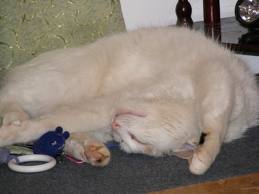In The Throes of Thursday--What I've Learned About Writing Novels_4

As if the world isn't already TENSE enough what withjust surviving another Rapture, today I'm going to focus on creating tension with dialogue. And I'm going to use a couple of plays as examples since they are great sources. Without tense dialogue the audience falls into a stupor.

In a Stupor
Here's a little bit from Edward Albee's Who's Afraid of Virginia Woolf--there are four characters in the room during this exchange--a young couple, Nick and his wife as well as George and Martha, the seasoned combatants.See if you feel just a touch of tension.
NICK (Peers at Martha)
Your eyes are ... brown, aren't they?
MARTHAGreen! (A little too fast) Well, in some lights they look brown but they're green. Not like his . . . more hazel. George has watery blue eyes. . . milky blue.
GEORGEMake up your mind, Martha.
MARTHAI was giving you the benefit of the doubt. (Now back to the others) Daddy has green eyes, too.
GEORGE He does not! Your father has tiny red eyes...like a white mouse. In fact, he is a white mouse.
MARTHAYou wouldn't dare say a thing like that if he was here! You're a coward!
Can you picture the other two people in the room with George and Martha? In the audience, I was cringing. What sharp spear of a word would they hurl at each other next?
Now, here's a small of bit of classic dialogue tension. The audience knows what Iago is up to and watches as he starts to weave his web of suspicion to trap Othello
IAGOMy Noble lord,--
OTHELLOWhat dost thou say, Iago?
IAGODid Michael Cassio, when you woo'd my lady, Know of your love?
OTHELLOHe did, from first to last: why dost thou ask?
IAGOBut for a satisfaction of my thought;No further harm.
OTHELLOWhy of thy thought,Iago?
IAGOI did not think he had been acquainted with her.
OTHELLOO,yes; and went between us very oft.
IAGOIndeed!
OTHELLOIndeed! ay, indeed" discern'st thou aught in that?Is he not honest?
IAGOHonest, my lord!
Notice that in these very different examples there are some similarities:
The language is lean. No fat, but lots of sub-text in each one. Martha choose the very unflattering adjectives, milky and watery, to describe George's eye color.
Iago chooses the single word, indeed, which I guess you could translate as, "foolish dupe." He then repeats Othello's word, honest, implying, "whatever!"
The words themselves seem pretty innocent, but their meaning isn't and that's what the reader picks up. That's what creates the tension.
Here are a couple of earlier post about dialogue if you'd like to see them.
Back to Basics i
Back to Basics ii
As always I really love your comments. If you have a great example or want to add to what I've shared, please do. I learn so much from my readers.Sliding on the Edge, C. Lee McKenzie, WestSide Books, Spring '09
Published on May 26, 2011 14:04
No comments have been added yet.



